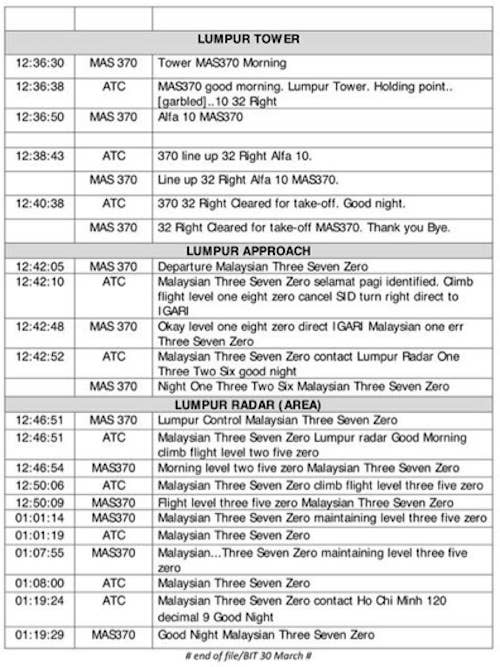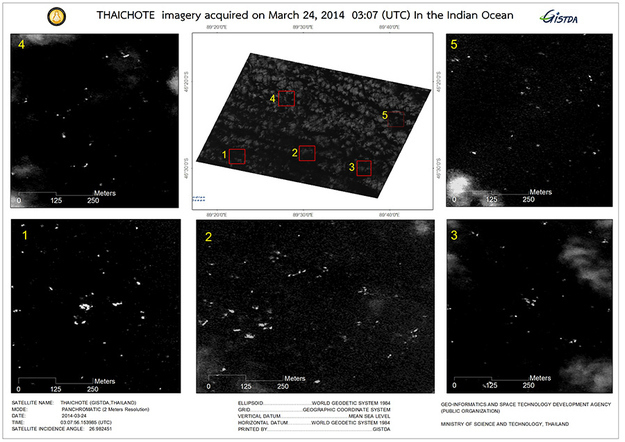
UPDATED — April 1, 5:15 a.m. ET:
The Malaysian government has released a full transcript of the communications between Flight 370 and the control tower in Kuala Lumpur, saying there were no abnormalities in the exchange. The most significant finding in the transcript is an update on what was initially initially believed to be the final words transmitted from the missing plane: "Good night Malaysian three seven zero" — not "all right, good night" as previously reported.
The transport ministry is working to confirm who spoke the final words, and whether it was the pilot or co-pilot as suspected.
On Tuesday, 10 planes — from Australia, China, Japan, Korea, Malaysia, New Zealand, and the U.S. — and nine ships will join the search effort in the Indian Ocean, looking for any signs of the missing plane.
The search area is based on satellite "pings" received from the plane after its last contact with air traffic control and covers 46,332 square miles.
Weather is not expected to be good on Tuesday, with low visibility, the Australian Joint Agency Co-ordination Centre said.
The search team has deployed a device that listens for ultrasonic signals from the plane's black box flight-data recorders. The signals from the black box are expected to last about 30 days.

Update — March 31, 5:20 a.m. ET:
The cluster of objects spotted by search crews in the southern Indian Ocean, described by Australia's Flight Lt. Russell Adams as one of "the most promising leads" in the now three-week search for Malaysia Airlines flight 370, is just fishing equipment.
Australian Prime Minister Tony Abbott, in a press conference on Monday, promised to carry on the search in spite of the setback. "This is an extraordinarily difficult exercise," said Abbott. "We are searching a vast area of ocean and we are working on quite limited information."
"If this mystery is solvable, we will solve it," he said.
Meanwhile, the families of Chinese passengers continued to express frustration and anger over the Malaysian government's handling of the missing plane. Following days of street protests in Beijing, dozens of the family members have traveled to Malaysia to demand more transparency from Malaysian officials.
The visiting protesters could be seen in the streets of Petaling Jaya, near Kuala Lumpur, holding signs that read "We want evidence, truth, dignity" and "Hand us the murderer. Tell us the truth. Give us our relatives back."
As conspiracy theories and rumors surrounding the disappearance of Flight 370 run rampant on Chinese social media — popular speculation includes that the plane was shot down to avoid a 9/11-style attack on Kuala Lumpur's Petronas Towers, that the plane was hijacked and landed in a remote stretch of Central Asia, and that the United States captured the plane to prevent state secrets from getting into the hands of the Chinese government — China's state-run China Daily has urged "rationality."
"We should not let anger prevail over facts," said an editorial on Monday.

Update — March 31, 12:45 a.m. ET:
After several objects that could be related to Malaysia Airlines Flight 370 were scooped up in the southern Indian Ocean this week, a warship with a black box detector was set to depart from Australia on Sunday to search for the plane, the Associated Press reported.
The Australian navy ship, the Ocean Shield, will help to determine whether the objects are from the missing Malaysian aircraft, but it will take three to four days for it to reach the search zone west of Australia. Along with the black box detector, the search ship is equipped with an unmanned underwater vehicle and other sounds detection equipment.
On Saturday, ships from China and Australia gathered items from the Indian Ocean, which have not yet been confirmed to be related to the missing jet.
In the sea southwest of Perth, 10 planes and 10 ships are still scouring for debris from the missing airliner.
"We can keep searching for quite some time to come," Australian Prime Minister Tony Abbott said.
"The intensity of our search and the magnitude of our search is increasing, not decreasing."

Updated — March 28, 10:15 p.m. ET:
Five aircraft searching a new area of the southern Indian Ocean for missing Malaysia Airlines Flight MH370 Friday spotted several objects floating in the water, Australian authorities said.
A New Zealand Air Force plane reported seeing a number of objects white or light in color, along with a fishing buoy while combing the area off the west coast of Australia. An Australian plane relocated the objects and reported it had seen two blue and gray rectangular items floating in the ocean.
Another Australian plane said it also spotted objects of various colors in a separate part of the search area about 340 miles away.
The Australian Maritime Safety Authority said it was not known if the objects were from the missing Boeing 777 until they could be recovered by ships, but at least one of the objects spotted during the search was determined to be fishing equipment.
"Our crew couldn't identify anything that would say it was definitely from the Malaysian aircraft," New Zealand Air Vice-Marshal Kevin Short said. "I think the main issue is that those objects will have to be picked up by a ship so they can physically examine them."
Short said a search plane spotted 11 objects Friday clustered in a small area about 1,000 miles west of Perth.
AMSA said it was analyzing photos taken from the plane and had tasked a Chinese ship to search the area Saturday to relocate the objects for further examination.
Updated — March 27, 11:50 p.m. ET:
The search for missing Malaysia Airlines Flight MH370 shifted dramatically Friday in the southern Indian Ocean after a "new credible lead" was received, Australian authorities said.
A new analysis of radar data between the South China Sea and the Strait of Malacca shows the plane was traveling faster than previously thought, the Australian Maritime Safety Authority said, resulting in increased fuel usage and reducing the possible distance the aircraft traveled into the Indian Ocean.
Australian officials have "examined this advice and determined that this is the most credible lead to where debris may be located," the AMSA said.
The search will shift to a new area 680 miles northeast based on the updated advice provided by the international investigation team in Malaysia. The new search area covers approximately 123,200 square miles and is located about 1,250 miles off the coast of Perth, Australia.
Ten aircraft, including a U.S. Navy P-8 Poseidon, will search the area for the missing plane, as well as six vessels, including the HMAS Success and five Chinese ships. Australia said it will also re-task its satellites to image the new area.
Should wreckage be found, Malaysia Airlines will make arrangements to bring family members of those on board the plane to Perth, the airline's CEO, Ahmad Jauhari Yahya, said.
An FBI search of a flight simulator and computer taken from the home of the missing plane's pilot, Zaharie Ahmad Shah, offered no explanation to what may have happened to the aircraft, the Wall Street Journal reported late Thursday, citing two unnamed officials.
Thailand said earlier Thursday its satellite had spotted 300 objects floating in the southern Indian Ocean near the search area for the missing Malaysian plane.
The objects range in size from 6 feet to 49 feet and were scattered in an area 1,680 miles southwest of Perth, Australia. The images were snapped by Thailand's only earth observation satellite on March 24 in a remote part of the Indian Ocean 125 miles from where a French satellite on Sunday spotted 122 objects.
Flight MH370 departed from Kuala Lumpur on March 8 and is believed to have flown thousands of miles off course and crashed, killing all 239 people onboard.


